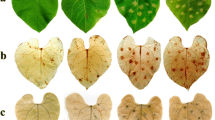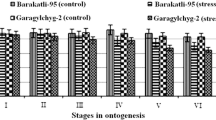Abstract
We analyzed the production of reactive oxygen species (ROS) and of detoxifying enzymes and enzymes of the ascorbate (ASC) acid cycle in avocado fruit (Pesea Americana Mill cv Hass) in response to wounding. The levels of superoxide anion (O2 −), hydroxyl radicals (OH.) and hydrogen peroxide (H2O2) increased at 15 min and 2 and 15 h post-wounding. Peroxidase (POD) activity had increased to high levels 24 h after wounding; in contrast, catalase and superoxide dismutase (SOD) levels hat decreased significantly at 24 h post-treatment. Basic POD was the major POD form induced, and the levels of at least three apoplastic POD isozymes –increased following wounding. Using specific inhibitors, we characterized one MnSOD and two CuZnSOD isozymes. CuZnSOD activities decreased notably 12 h after treatment. The activities of dehydroascorbate reductase and glutathione reductase increased dramatically following the wounding treatment, possibly as a means to compensate for the redox changes due to ROS production.




Similar content being viewed by others
References
Andrews J, Malone M, Thompson DS, Ho LC, Burton KS (2000) Peroxidase isozyme patterns in the skin of maturing tomato fruit. Plant Cell Environ 23:415–422. doi:10.1046/j.1365-3040.2000.00555.x
Arrigoni O, Calabrese G, De Gara L, Bitoni MB, Liso R (1997) Correlation between changes in cell ascorbate and growth of Lupinus albus seedlings. J Plant Physiol 150:302–308
Barnes JD, Zheng Y, Lyons TM (2002) Plant resistance to ozone: the role of ascorbate. In: Omasa K, Saji H, YousseWan S, Kondo N (eds) Air pollution and plant biochemistry: prospects for phytomonitoring and phytoremediation. Springer, Berlin, Heidelberg, New York, pp 235–252
Beauchamp C, Fridovich I (1971) Superoxide dismutase: Improved assays and an assay applicable to acrylamide gels. Anal Biochem 44:276–287. doi:10.1016/0003-2697(71)90370-8
Bower JP, Cutting JGM (1988) Avocado fruit development and ripening physiology. Hort Rev 10:229–271
Bradford MM (1976) A rapid and sensitive method for the quantification of microgram quantities of protein using the principles of protein dye-binding. Anal Biochem 72:248–254. doi:10.1016/0003-2697(76)90527-3
Cassano LM, Gómez LD, Lascano HR, González CA, Trippi VS (1997) Inactivation and degradation of CuZn-SOD by active oxygen species in wheat chloroplasts exponed to photooxidative stress. Plant Cell Physiol 38:433–440
Cheong YH, Chang HS, Gupta R, Wang X, Zhu T, Luan S (2002) Transcriptional profiling reveals novel interactions between wounding, pathogen, abiotic stress, and hormonal response in Arabidopsis. Plant Physiol 129:661–677. doi:10.1104/pp.002857
Conklin PL, Saracco SA, Norris SR, Last RL (2000) Identification of ascorbic acid-deficient Arabidopsis thaliana mutants. Genetics 154:847–856
Córdoba-Pedregosa MC, Córdoba F, Villalba JM, González-Reyes JA (2003) Differential distribution of ascorbic acid, peroxidase activity, and hydrogen peroxide along the root axis in Allium cepa L. and its possible relationship with cell growth and differentiation. Protoplasma 221:57–65. doi:10.1007/s00709-002-0069-9
Córdoba-Pedregosa MC, Villalba JM, Córdoba F, González-Reyes JA (2005) Changes in intracellular and apoplastic peroxidase activity, ascorbate redox status, and root elongation induced by enhanced ascorbate content in Allium cepa L. J Exp Bot 56:685–694. doi:10.1093/jxb/eri051
Creissen GJ, Firmin M, Freyer B, Kular N, Leyland H, Reynolds G, Pastori F, Wellburn N, Baker A, Mullineaux WP (1999) Elevated glutathione biosynthetic capacity in the chloroplasts of transgenic tobacco paradoxically caused increased oxidative stress. Plant Cell 11:1277–1291
De Gara L, Paciolla De Tullio CM, Motto M, Arrigoni O (2000) Ascorbate-dependent hydrogen peroxide detoxification and ascorbate regeneration during germination of a highly productive Maite hybrid: Evidence of an improved detoxification mechanism against reactive oxygen species. Plant Physiol 109:7–13. doi:10.1034/j.1399-3054.2000.100102.x
Desikan R, Mackerness SAH, Hancock JT, Neill SJ (2001) Regulation of the Arabidopsis transcriptome by oxidative stress. Plant Physiol 127:159–172. doi:10.1104/pp.127.1.159
Doke N (1983) Involvement of superoxide anion generation in hypersensitive response of potato tuber tissues to infection with an incompatible race of Phythphthora infestans. Physiol Plant Pathol 23:345–347. doi:10.1016/0048-4059(83)90019-X
Foyer CH, Halliwell B (1976) The presence of glutathione and glutathione reducatase in chloroplasts: a proposed role in ascorbic acid metabolism. Planta 133:21–25. doi:10.1007/BF00386001
Foyer CH, Noctor G (2005) Redox homeostasis and antioxidant signalling: a metabolic interface between stress perception and physiological responses. Plant Cell 17:1866–1875. doi:10.1105/tpc.105.033589
García-Pineda E, Castro-Mercado E, Lozoya-Gloria E (2004) Gene expression and enzyme activity of pepper (Capsicum annumm L.) ascorbate oxidase during elicitor and wounding stress. Plant Sci 166:237–243. doi:10.1016/j.plantsci.2003.09.013
Grantz AA, Brummell D, Bennett AB (1995) Ascorbate free radical reductase mRNA levels are induced by wounding. Plant Physiol 108:411–418 doi:10.1104/pp.108.1.411
Hammerschmidt R, Nuckles EM, Kuc J (1982) Association of anhanced peroxidase activity with induced systemic resistance of cucumber to Colletotrichum lagenarium. Physiol Plant Pathol 20:73–82. doi:10.1016/0048-4059(82)90025-X
Hiraga S, Sasaki K, Ito H, Ohashi Y, Matsui H (2001) A large familiy of class III plant peroxidases. Plant Cell Physiol 42:462–468. doi:10.1093/pcp/pce061
Hodgson EK, Fridovich I (1975) The interaction of bovine erythrocyte superoxide dismutase with hydrogen peroxide: inactivation of enzyme. Biochemistry 14:5294–5299. doi:10.1021/bi00695a010
Hofman PJ, Fuchs Y, Milne DL (2002) Harvesting, parking, postharvest technology, transport and processing. In: Whiley AW, Schaffer B, Wolstenholme BN (eds) The avocado: botany, production and uses. CABI, New York, pp 363–401
Holm KB, Andreasen PH, Eckloff RMG, Kristensen BK, Rasmussen SK (2003) Three differentially expressed basic peroxidases from wound-lignifying Asparagus officinalis. J Exp Bot 54:2275–2284. doi:10.1093/jxb/erg253
Huh GH, Lee SJ, Bae YS, Liu JR, Kwak SS (1997) Molecular cloning and characterization of cDNAs for anionic and neutral peroxidases from suspension cultured-cells of sweet potato and their differential expression in response to stress. Mol Gen Genet 255:382–391. doi:10.1007/s004380050510
Ishikawa T, Dowdle J, Smirnoff N (2006) Progress in manipulating ascorbic acid biosynthesis and accumulation in plants. Physiol Plant 126:343–355. doi:10.1111/j.1399-3054.2006.00640.x
Kahn V (1983) Multiple effects of hydrogen peroxide on the activity of avocado polyphenol oxidase. Phychemistry 22:2155–2259. doi:10.1016/S0031-9422(00)80136-3
Karpinska B, Karlsson M, Schinkel H, Streller S, Sus KH, Melzer M, Wingsle G (2001) A novel superoxide dismutase with a high isoelectric point in higher plants. Expression, regulation, and protein localization. Plant Physiol 126:1668–1677. doi:10.1104/pp.126.4.1668
Kliebenstein DJ, Monde RA, Last RL (1998) Superoxide dismutase in Arabidopsis: on eclectic enzyme family with disparate regulation and protein localization. Plant Physiol 118:637–650. doi:10.1104/pp.118.2.637
Kvaratskhelia M, Winkel C, Naldrett MT, Thorneley RNF (1999) A novel high activity cationic ascorbate peroxidase from tea (Camellia sinensis) - a class III peroxidase with unusual substrate specificity. J Plant Physiol 154:273–282
Lagrimini LM, Rothstein S (1987) Tissue specificity of tobacco peroxidase isozymes and their induction by wounding and tobacco mosaic virus infection. Plant Physiol 84:438–442. doi:10.1104/pp.84.2.438
Lamb C, Dixon RA (1997) The oxidative burst in plant disease resistance. Annu Rev Plant Mol Biol 48:251–275. doi:10.1146/annurev.arplant.48.1.251
Leon J, Rojo E, Sanchez-Serrano JJ (2001) Wound signaling in plants. J Exp Bot 52:1–9. doi:10.1093/jexbot/52.354.1
Liochev S, Fridovich I (1994) The role of superoxide anion radicals I the production of hydroxyl radicals: in vitro and in vivo. Free Radic Biol Med 16:29–33. doi:10.1016/0891-5849(94)90239-9
Loprasert S, Vattanaviboon P, Praituan W, Chamnongpol S, Mongkolsuk S (1996) Regulation of the oxidative stress protective enzymes, catalase and superoxide dismutase in Xanthomonas—a review. Gene 179:33–37. doi:10.1016/S0378-1119(96)00427-1
Mika A, Luthje S (2003) Properties of guaiacol peroxidase activities isolated from corn root plasma membranes. Plant Physiol 132:1489–1498. doi:10.1104/pp.103.020396
Mittler R (2002) Oxidative stress, antioxidants and stress tolerance. Trends Plant Sci 7:405–410. doi:10.1016/S1360-1385(02)02312-9
Noctor G, Foyer CH (1998) Ascorbate and glutathione: keeping active oxygen under control. Annu Rev Plant Physiol Plant Mol Biol 49:249–279. doi:10.1146/annurev.arplant.49.1.249
Orozco-Cárdenas M, Ryan CA (1999) Hydrogen peroxide is generated systemically in plant leaves by wounding and systemin via the octadecanoid pathway. Proc Natl Acad Sci USA 96:6553. doi:10.1073/pnas.96.11.6553
Orozco-Cárdenas M, Narvaez-Vasquez J, Ryan C (2001) Hydrogen peroxide acts as a second messenger for the induction of defense genes in tomato plants in response to wounding, systemin, and methyl jasmonate. Plant Cell 13:179–191
Pastori GM, Kiddle G, Antoniw J, Bernard S, Veljovic-Jovanovic S, Verrier PJ, Noctor G, Foyer CH (2003) Leaf vitamin C contents modulate plant defense transcripts and regulate genes that control development through hormone signaling. Plant Cell 15:939–951. doi:10.1105/tpc.010538
Pignocchi C, Foyer CH (2003) Apoplastic ascorbate metabolism and its role in the regulation of cell signalling. Curr Opin Plant Biol 6:379–389. doi:10.1016/S1369-5266(03)00069-4
Roberts E, Kutchan T, Kolattukudy PE (1988) Cloning and sequencing of cDNA for a highly anionic peroxidase from potato and the induction of its mRNA in suberizing potato tubers and tomato fruits. Plant Mol Biol 11:15–26. doi:10.1007/BF00016010
Rustérucci C, Stallaert V, Milat ML, Pugin A, Ricci P, Blein JP (1996) Relationship between active oxygen species, lipid peroxidation, necrosis, and phytoalexin production induced by elicitins in Nicotiana. Plant Physiol 111:885–891
Rustérucci C, Aviv DH, Holt BF, Dangl JL, Parker JE (2001) The disease resistance signaling components EDS1 and PAD4 are essential regulators of the cell death pathway controlled by LSD1 in Arabidopsis. Plant Cell 13:2211
Ryan CA (2000) The systemin signaling pathway: differential activation of plant defensive genes. Biochim Biophys Acta 1477:112–121
Sanmartin M, Pateraki I, Chatzopoulou F, Kanellis AK (2007) Differential expression of the ascorbate oxidase multigene family during fruit development and in response to stress. Planta 225:873–885. doi:10.1007/s00425-006-0399-5
Scandalios JG (1993) Oxygen stress and superoxide dismutases. Plant Physiol 101:7–12
Shah J (2003) The salicylic acid loop in plant defense. Curr Opin Plant Biol 6:365–371. doi:10.1016/S1369-5266(03)00058-X
Smirnoff N (2000) Ascorbic acid: metabolism and functions of a multi-facetted molecule. Curr Opin Plant Biol 3:229–235
Strack PR, Waxman L, Fagan JM (1996) ATP-stimulated degradation of oxidatively modified superoxide dismutase by cathepsin D in cardiac tissue extracts. Biochem Biophys Res Commun 219:348–353. doi:10.1006/bbrc.1996.0236
Svalheim O, Robertsen B (1990) Induction of peroxidases in cucumber hypocotyls by wounding and fungal infection. Physiol Plant 78:261–267. doi:10.1111/j.1399-3054.1990.tb02090.x
Wheeler GL, Jones MA, Smirnoff N (1998) The biosynthetic pathway of vitamin C in higher plants. Nature 393:365–369. doi:10.1038/30728
Yahraus T, Chandra S, Legendre L, Low PS (1995) Evidence for mechanically induced oxidative burst. Plant Physiol 109:1259–1266
Acknowledgements
The funding of this work by the Consejo Nacional de Ciencia y Tecnología (CONACYT, 43438-Z) is gratefully acknowledged. We thank A. Saavedra-Molina for critically reading the manuscript.
Author information
Authors and Affiliations
Corresponding author
Rights and permissions
About this article
Cite this article
Castro-Mercado, E., Martinez-Diaz, Y., Roman-Tehandon, N. et al. Biochemical analysis of reactive oxygen species production and antioxidative responses in unripe avocado (Persea americana Mill var Hass) fruits in response to wounding. Protoplasma 235, 67–76 (2009). https://doi.org/10.1007/s00709-009-0034-y
Received:
Accepted:
Published:
Issue Date:
DOI: https://doi.org/10.1007/s00709-009-0034-y




